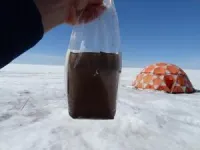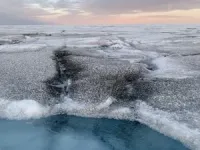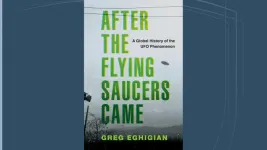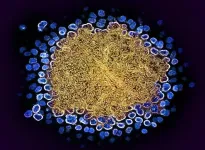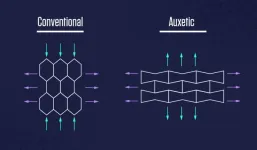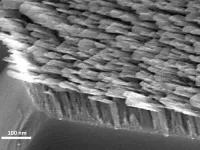(Press-News.org) Every spring when the sun rises in the Arctic after months of darkness, life returns. The polar bears pop up from their winter lairs, the arctic tern soar back from their long journey south and the musk oxen wade north.
But the animals are not the only life being reawakened by the spring sun. Algae lying dormant on the ice starts blooming in spring blackening large areas of the ice.
When the ice blackens it’s ability to reflect the sun diminishes and this accelerates the melting of the ice. Increased melting exacerbates global warming.
But researchers might have found a way to control the snow algae growth – and maybe in the long run reduce some of the ice from melting. Living on the ice alongside the algae, postdoc Laura Perini from the Department of Environmental Science at Aarhus University and her colleagues, have found giant viruses.
She suspects that the viruses feed on the snow algae and could work as a natural control mechanism on the algae blooms.
- We don’t know a lot about the viruses, but I think they could be useful as a way of alleviating ice melting caused by algal blooms. How specific they are and how efficient it would be, we do not know yet. But by exploring them further, we hope to answer some of those questions, she says.
Bigger than bacteria
Viruses are normally much smaller than bacteria. Regular viruses measure 20-200 nanometers in size, whereas a typical bacteria is 2-3 micrometers. In other words a normal virus is around 1000 times smaller than a bacteria.
That is not the case with giant viruses though.
Giant viruses grow to the size of 2,5 micrometers. That is bigger than most bacteria.
But the giant viruses are not only bigger in size. Their genome is much bigger than regular viruses. Bacteriophages – virus infecting bacteria – have between 100.000 and 200.000 letters in their genome. Giant viruses have around 2.500.000.
Never found on the ice before
Giant viruses were first discovered in 1981, when researchers found them in the ocean. These viruses had specialized in infecting green algae in the sea. Later, giant viruses were found in soil on land and even in humans.
But it’s the first time that giant viruses have been found living on the surface ice and snow dominated by microalgae, Laura Perini explains.
- We analyzed samples from dark ice, red snow and melting holes (cryoconite). In both the dark ice and red snow we found signatures of active giant viruses. And that is the first time they’ve been found on surface ice and snow containing a high abundance of pigmented microalgae.
A few years ago everyone thought this part of the world to be barren and devoid of life. But today we know that several microorganisms live there – including the giant viruses.
- There’s a whole ecosystem surrounding the algae. Besides bacteria, filamentous fungi and yeasts, there are protists eating the algae, different species of fungi parasitizing them and the giant viruses that we found, infecting them.
- In order to understand the biological controls acting on the algal blooms, we need to study these last three groups.
Haven’t seen them with the naked eye
Even though the viruses are giant, they can’t be seen with the naked eye. Laura Perini hasn’t even seen them with a light microscope yet. But she hopes to do so in the future.
- The way we discovered the viruses was by analyzing all the DNA in the samples we took. By sifting through this huge dataset looking for specific marker genes, we found sequences that have high similarity to known giant viruses, she explains.
To make sure that the viral DNA didn’t come from long dead microorganisms, but from living and active viruses, they also extracted all the mRNA from the sample.
When the sequences of the DNA that form genes are activated, they are transcribed into single stranded pieces called mRNA. These pieces work as recipes for building the proteins the virus needs. If they are present the virus is alive.
- In the total mRNA sequenced from the samples, we found the same markers as in the total DNA, so we know they have been transcribed. It means that the viruses are living and active on the ice, she says.
DNA and RNA in viruses
At the center of the giant viruses is a cluster of DNA. That DNA contains all the genetic information or recipes needed to create proteins – the chemical compounds that are doing most of the work in the virus.
But in order to use those recipes, the virus needs to transcribe them from double-stranded DNA to single stranded mRNA.
Normal viruses can’t do that. Instead they have strands of RNA floating around in the cell waiting to be activated, when the virus infects an organism and hijacks its cellular production facilities.
Giant viruses can do that themselves which makes them very different from normal viruses.
Whereas DNA from dead viruses can be found in samples, mRNA is broken down much faster. mRNA is therefore an important marker of viral activity. In other words mRNA-recipes of certain proteins show that the viruses are alive and kicking.
Not sure exactly how they work
Because giant viruses are a relatively new discovery not a lot is known about them. In contrast to most other viruses they have a lot of active genes that enable them to repair, replicate, transcribe and translate DNA.
But why that is and exactly what they use it for is not known.
- Which hosts the giant viruses infect, we can’t link exactly. Some of them may be infecting protists while others attack the snow algae. We simply can’t be sure yet, Laura Perini says.
She’s working hard on discovering more about the giant viruses and has more research coming out soon.
- We keep studying the giant viruses to learn more about their interactions and what is exactly is their role in the ecosystem. Later this year we’ll release another scientific with some more info on giant viruses infecting a cultivated microalgae thriving on the surface ice of the Greenland Ice Sheet, she concludes.
END
Giant viruses found on Greenland ice sheet
The viruses probably regulate the growth of snow algae on the ice by infecting them. Knowing how to control these viruses could help us reduce some of the ice from melting
2024-06-04
ELSE PRESS RELEASES FROM THIS DATE:
SNMMI Annual Meeting to take place June 8-11, 2024
2024-06-04
WHAT: The Society of Nuclear Medicine and Molecular Imaging 2024 Annual Meeting
The field of nuclear medicine is undergoing rapid and widespread growth—offering patients increasingly precise, tailored, painless diagnosis and treatment with minimal side effects and exceptional results.
This year’s program will focus on new radiopharmaceuticals, instrumentation, and techniques for managing a wide range of diseases, from cancer, brain, and heart disease to infection and inflammation.
The meeting will convene more than 6,500 attendees from around the globe. With more than 100 ...
Flying saucers and alien abductions: New book explores history of UFOs
2024-06-04
UNIVERSITY PARK, Pa. — The end of the Second World War ushered in a new age, one dominated by novel technologies, the Cold War, the threat of nuclear destruction — and the first reported UFO sightings.
Humans have witnessed strange aerial events since ancient times, but what makes UFOs unique is that the term “unidentified flying object” represents both a concept and a theory, according to Greg Eghigian, professor of history and bioethics at Penn State. In his new book, “After the Flying Saucers Came: A Global History of the UFO Phenomenon,” Eghigian explores how individuals, scientists, governments ...
Lost in lockdown: Study reveals feeling isolated from others can warp our perception of time
2024-06-04
Feelings of loneliness and social isolation during the pandemic left many people confused about the order of events and struggling to remember what day of the week it was, a new study reveals.
The research, from the University of York, looked at the psychological impact of the pandemic, which spread to the UK in March 2020, through the lens of disorientation.
The researchers asked more than 3,300 French participants nearly 60 questions analysing the psychological effects of lockdowns. The survey took place during an acute phase of restrictions when there was a lockdown followed by a strict curfew.
The findings ...
U.S. clinical trials begin for twice-yearly HIV prevention injection
2024-06-04
WHAT:
Two clinical trials have launched to examine a novel long-acting form of HIV pre-exposure prophylaxis (PrEP) in cisgender women and people who inject drugs. The mid-stage studies will assess the safety, acceptability, and pharmacokinetic (how a drug moves through the body) of lenacapavir, an antiretroviral drug administered by injection every six months. The studies are sponsored and funded by Gilead Sciences, Inc., and implemented through the HIV Prevention Trails Network (HPTN). The HPTN is supported by grants from the National Institute of Allergy and Infectious Diseases (NIAID), part of the National Institutes of ...
Combining pest treatments may be key to helping honey bees survive the winter
2024-06-04
UNIVERSITY PARK, Pa. — Winters can be tough on managed honey bee colonies, with beekeepers in the United States reporting that one-third of their colonies die each winter. A new study by Penn State researchers has found that using not one but multiple pest treatments may help bees make it to spring.
The researchers found that beekeepers who used a combination of treatments for Varroa mites — tiny parasites that can weaken and spread diseases to honey bees — had higher winter colony survival than those who used only one type of treatment. The findings were published in the Journal of Insect Science.
Additionally, ...
UTA program helps students achieve medical school dreams
2024-06-04
Getting into graduate school to become a doctor or a dentist is difficult. By some estimates, only about 37% to 42% of students who apply to medical or dental school are accepted.
To help pre-medical and -dental students achieve their dreams, UT Arlington created a program called the Health Professions Advisory Committee (HPAC). The odds of graduate school admission for students participating in HPAC is significantly higher than average, with an estimated 85% succeeding.
This is just one of several UT Arlington initiatives helping alleviate ...
Rocky shores of Pacific Northwest show low resilience to changes in climate
2024-06-04
CORVALLIS, Ore. – A 15-year period ending in 2020 that included a marine heat wave and a sea star wasting disease epidemic saw major changes in the groups of organisms that live along the rocky shores of the Pacific Northwest.
The study by Oregon State University scientists, involving four capes in Oregon and California, suggests these communities of species may have low resilience to climate change. Findings were published Monday in Nature Ecology & Evolution and.
Researchers learned that ...
A new way of designing auxetic materials
2024-06-04
Imagine pulling on the long ends of a rectangular piece of rubber.
It should become narrower and thinner.
But what if, instead, it got wider and fatter?
Now, push in on those same ends. What if the rubber became narrower and thinner?
Such common-sense-defying materials do exist. They’re called auxetics, and they have a raft of unique properties that make them well-suited for sneaker insoles, bomb-resilient buildings, car bumpers and clothing.
Despite this great potential, auxetic products have been slow to market. Researchers at the National Institute of Standards and Technology (NIST) and the University of Chicago hope to change this.
In a new study published ...
Neurocognitively-defined subtypes in bipolar disorder: a path to more personalized treatments
2024-06-04
The Brain & Behavior Research Foundation (BBRF) is hosting a free webinar, “Neurocognitively-Defined Subtypes in Bipolar Disorder: A Path to More Personalized Treatments” on Tuesday, June 11, 2024, at 2:00 pm ET. The presenter, Katherine E. Burdick, PhD, is the Jonathan F. Borus, MD Distinguished Chair in Psychiatry and the Vice Chair for Research in Psychiatry at Brigham and Women’s Hospital. She is the Director of the Mood and Psychosis Research Program at BWH and a Professor at Harvard Medical ...
Shining a light on molecules: L-shaped metamaterials can control light direction
2024-06-04
UNIVERSITY PARK, Pa. — Polarized light waves spin clockwise or counterclockwise as they travel, with one direction behaving differently than the other as it interacts with molecules. This directionality, called chirality or handedness, could provide a way to identify and sort specific molecules for use in biomedicine applications, but researchers have had limited control over the direction of the waves — until now.
Using metamaterials, a team of electrical engineering researchers from Penn State and the University of Nebraska-Lincoln ...
LAST 30 PRESS RELEASES:
Manta rays create mobile ecosystems, study finds
Study: Mixed results in using lipoic acid to treat progressive multiple sclerosis
Norbert Holtkamp appointed director of Fermi National Accelerator Laboratory
New agentic AI platform accelerates advanced optics design
Biologists discover neurons use physical signals — not electricity — to stabilize communication
Researchers discover that a hormone can access the brain by hitchhiking
University of Oklahoma researcher awarded funding to pursue AI-powered material design
Exploring how the visual system recovers following injury
Support for parents with infants at pediatric check-ups leads to better reading and math skills in elementary school
Kids’ behavioral health is a growing share of family health costs
Day & night: Cancer disrupts the brain’s natural rhythm
COVID-19 vaccination significantly reduces risk to pregnant women and baby
The role of vaccination in maternal and perinatal outcomes associated with COVID-19 in pregnancy
Mayo Clinic smartwatch system helps parents shorten and defuse children's severe tantrums early
Behavioral health spending spikes to 40% of all children’s health expenditures, nearly doubling in a decade
Digital cognitive behavioral treatment for generalized anxiety disorder
Expenditures for pediatric behavioral health care over time and estimated family financial burden
Air conditioning in nursing homes and mortality during extreme heat
The Alps to lose a record number of glaciers in the next decade
What makes a good proton conductor?
New science reporting guide published for journalists in Bulgaria
New international study reveals major survival gaps among children with cancer
New science reporting guide published for journalists in Turkey
Scientists develop a smarter mRNA therapy that knows which cells to target
Neuroanatomy-informed brain–machine hybrid intelligence for robust acoustic target detection
Eight SwRI hydrogen projects funded by ENERGYWERX
The Lundquist Institute and its start-up company Vitalex Biosciences Announces Strategic Advancement of Second-Generation fungal Vaccine VXV-01 through Phase 1 Trials under $40 Million Competitive Con
Fine particles in pollution are associated with early signs of autoimmune disease
Review article | Towards a Global Ground-Based Earth Observatory (GGBEO): Leveraging existing systems and networks
Penn and UMich create world’s smallest programmable, autonomous robots
[Press-News.org] Giant viruses found on Greenland ice sheetThe viruses probably regulate the growth of snow algae on the ice by infecting them. Knowing how to control these viruses could help us reduce some of the ice from melting

